长江大学外国语学院本科毕业论文(设计)写作格式说明
一、总的装订顺序(亦即本说明之排列顺序)
1. 外封
2. 内封(中文)
3. 内封(英文
4. 目录
5. 摘要(中文)
6. 摘要(英语)
7. 正文
8. 参考文献
9. 致谢
二、特别提示:
1. 本文本之页码、内容等仅为格式参考。如无特殊说明,请参照执行。
2. 论文写作请参考《长江大学毕业设计(论文)评分参考标准(文科类专业)》,特别注意正文中的英文字符数不少于3万字符(以word统计为准)。参考文献不少于20种且英文文献不少于5种;开题报告(或文献综述)2500汉字以上;摘要中文字数400字以上,每少40个字学校检查时扣10%分数。中外文文字表达正确;文字通顺、语言流畅、无错别字,论文打印工整;标点符号、计量单位使用准确;图纸、框图、表格、曲线等符合国家标准或工程要求。论文论点鲜明、有创见;论据确凿,结构严谨,逻辑性强,论述层次清晰,表现出对实际问题有较强的分析能力和概括能力,文章材料详实可靠,有说服力。
3. 审核表是论文开题前,由学院对学生选题的筛选内容,所以不随本论文装订,而是单独上交。
4.
-1-
学生姓名:张山
院 (系)辅导教师:
时 毕业论文


题目,
黑体,
二号。 英汉思维差异对翻译的影响
张山
总计:毕业论文33页
指导教师:郑厚尧
评阅教师:李璐
完成日期:20xx年6月6日
学生姓名,宋体,小四号,加粗。 论文中致谢页的页码。
The Effect of Thinking Modes on
Translation Between English and Chinese
A Thesis
Presented to the School of Foreign Studies
Yangtze University
By Zhang Shan
In Partial Fulfillment of the Requirements
For the Degree of
Bachelor of Arts
June 2015
Thesis Supervisor: Zheng Houyao
注:前几届为School of Foreign Languages,现统一改为:School of Foreign Studies
毕业论文目录
“指导老师审查意见”至“正文目录”的页码全部采用罗马大写字母。具体页码编号,自I开始,依次排列。
指导老师审查意见 ????????????????I 评阅老师评语 ????????????????????II 答辩会议记录及成绩评定 ???????????????III 任务书 ???????????????????????IV 文献综述 ?????????????????????V 中文摘要 ?????????????????????Ⅻ 英文摘要???????????????????????X 正文目录???????????????????????X 正文 ????????????????????????1 参考文献 ?????????????????????32 致谢 ????????????????????????34 附录????????????????????????
从论文正文引言开始,直
到致谢,页码用阿拉伯数字从1往后依次排序。
I
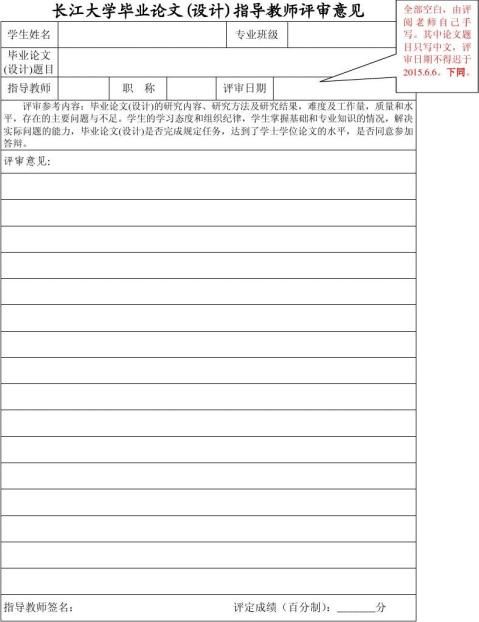
长江大学毕业论文(设计)评阅教师评语
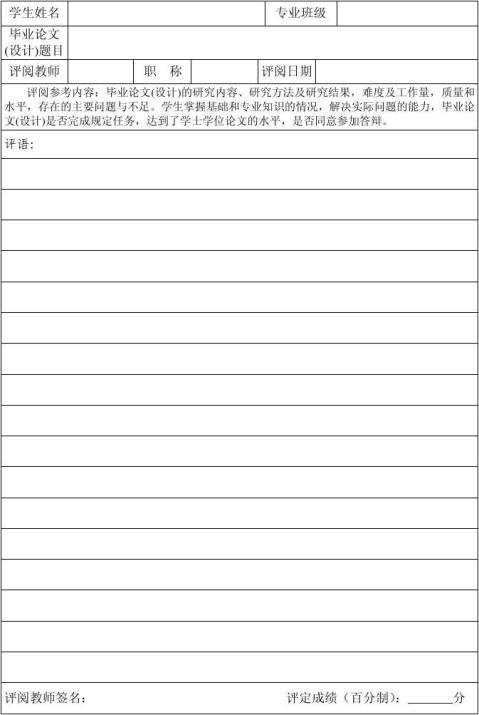
II
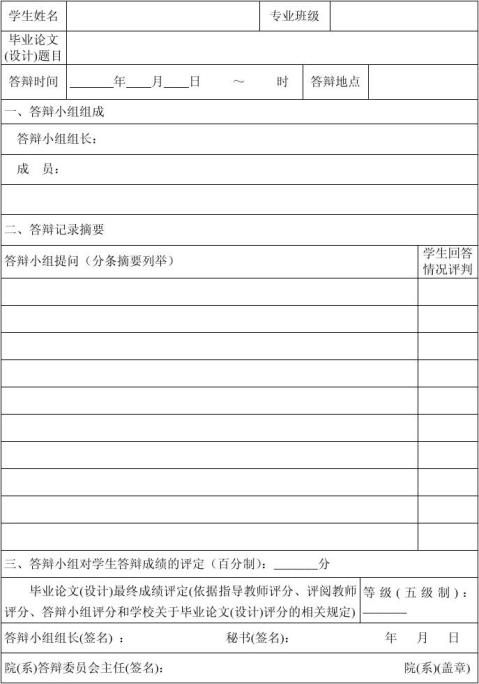
III
长江大学毕业论文任务书
学院(系) 外国语学院 专业

学生姓名 张山 指导教师/职称 郑厚尧/教授
1. 毕业设计(论文)题目:
英汉思维差异对翻译的影响
The Effect of Thinking Modes on Translation Between English and Chinese
2. 毕业设计(论文)起止时间
20xx年11月20日~20xx年6月6日 外文文献不得少于5项,文献总数不少于20项。外文在前,
中文在后,按姓氏字母顺序排列。
3. 毕业设计(论文)
格式示例。详细格式请参考:长江大学外国语学院本科毕业论文(设计)参考文献格式.doc Alderson, J. Charles, Caroline Clapham and Dianne Wall. Language Test Construction
and Evaluation[M]. Cambridge University Press, 1995: 171-177.
Bly, Robert. The Eight Stages of Translation[A]. William Frawley. ed. Translation:
Literary, Linguistics, and Philosophical Perspectives[C]. University of Delaware Press, 1984: 67-89.
Gavison, Ruth. Legal Protection of Privacy[D]. An Oxford University Dissertation,
1975.
Hale, Gordon A. and Rosalea Courtney. The Effects of Note-Taking on Listening
Comprehension in the Test of English as a Foreign Language[J]. Language Testing, 1994(1): 29-48.
Online Computer Library Center, Inc. History of OCLC[EB/OL]. [2000-01-08].
/about.en.html.
Richards, Jack C. Listening Comprehension: Approach, Design, Procedure. TESOL
Quarterly[J], 1983(17): 219-240.
Wang, Ning. Globalization and Cultural Translation[M].Cavendish Square Publishing,
2005.
[德]海德格尔.存在与时间[M].陈嘉映,王庆节译.生活?读书?新知三联书
店,1999:2-3.
[美]杰夫?特威切尔.庞德的《华夏集》和意象派诗[J].张子清译.外国文学评论,
1992(1):86-91.
曹明伦.“我是否可以把你比喻成夏天?”——兼与沈弘先生商榷[J].外国文学评
论,2008(3):35-40.
丁文祥. 数字革命与竞争国际化[N].中国青年报,2000-11-20(15).
国家标准局信息分类编码研究所.GB/T 2659-1986 世界各国和地区名称代码
[S]//全国文献工作标准化技术委员会.文献工作国家标准汇编:3.中国标准出版社,1988:59-92.
蒋显菊.国内英语测试研究:十年回顾与展望[J].外语界,2007(2):89-96. IV
萧钰. 出版业信息化迈入快车道[EB/OL]. (2001-12-19) [2002-04-15].
/01ds/2001-12/19/07-1C6612DEBB971BF148256B2700043
372.htm.
张俊杰.试论中庸诗歌翻译观的构建[D].河南大学博士论文,2010.
钟玲.王红公英诗里的中国风味[A].郑树森,周英雄和袁鹤翔合编.中西比较文学
论集[C].时报文化出版事业有限公司,1980:103-134.
邹申.语言测试[M].上海外语教育出版社,2005:25.
4.毕业设计(论文)应完成的主要内容
(一)语言与思维的关系
1.1 从心理学角度分析中西方的思维差异
1.2 从语言学角度分析中西方的思维差异
1.3 从心理学及语言学两方面探讨语言与思维的关系
(二)英汉思维差异对翻译的影响
2.1 思维方式差异对翻译的影响
2.2 翻译实践中如何避免思维方式差异导致的翻译问题
5.毕业设计(论文)的目标及具体要求
1)在学校图书馆查阅相关的文献,为论文的写作做准备;
2)拟订粗线条的论文大纲,指导教师认可后撰写详细的论文大纲;
3)论文大纲获得指导教师的认可后,开始准备任务书和开题报告;
4)按照规定的时间上交任务书和开题报告;
5)开题报告获得通过后,进入论文的写作阶段。在论文的写作阶段要与指导教师经常联系,并定期向指导教师汇报论文的写作情况及进展;
6)按时提交论文的初稿和修改稿,并做好论文答辩的准备;
7)通过对以上任务的完成,对翻译的策略有了进一步认识。
6、完成毕业设计(论文)所需的条件及上机时数要求
1) 查阅一定的与本论文有关的中英文资料;
2) 在校内图书馆,校外图书馆查阅大量相关的资料;
3) 至少200小时的上机时间。
靠底部对齐。必须由师生亲笔签名,不可打印替代。
任务书批准日期 2014 年 12 月 25 日 教研室(系)主任(签字) 任务书下达日期 20xx年 12 月 28 日 指导教师(签字) 完成任务日期 2014 年 12 月 28 日 学生(签名) V
长江大学 毕业论文文献综述
题 目 名

学 院(系)专 业 班 级:英语10801班 学 生 姓 名:张山 指 导 教 师:郑厚尧 辅 导 教 师: 完 成 日 期:20xx年12月31日 VI
文献综述 外国语学院
文献综述
学生:张山,外国语学院英语系
指导教师:郑厚尧,外国语学院英语系
1.

(简要说明写作本文的目的和涉及的范围,必要时简介本课题的历史背景、发展现状和争论焦点。字数一般在300字左右。)
随着经济全球化的不断深入,商务谈判已成为商业人士工作的重要一部分,尤其是国际商务谈判,其玄机无限。商务谈判的实质是谈判者运用语言彼此沟通、协商、谋求一致、达成协议的过程。在商务谈判中如何提问对谈判者来说是至关重要的。当然,谈判策略的配合使用,掌握常见的谈判策略这是前提。掌握了谈判中提问的策略与语言技巧,也就抓住谈判的主动权,因此本文谈谈商务谈判中提问策略。另外,语言在谈判中的中心地位不可忽视。在谈判中准确运用语言非常关键。因此,商务人员在谈判过程中应注重谈判的语言技巧。商务谈判中通过精妙的提问可以了解对方的想法和意图,掌握更多的信息,同时“问”也是表达自己情感的手段,促进双方的沟通。如何“问”是很有讲究的。选择正确的提问策略,不仅可以引起双方的讨论,还可以控制谈判的方向,掌握谈判的主动权。本文就如上这些问题,在总结前人的成果和自己的思考下,浅谈一下自己的认识。
2. 有关商务谈判的研究及其主要论点
(主体是综述的基础和核心部分。主要通过提出问题,分析问题,综合前人文献中提出的理论和事实,比较各种学术观点,阐明所提问题的历史、现状及发展方向等。一般可以按照题目大小,内容多少及逻辑关系,安排不同层次的大小标题。按论点和论据组织材料。从不同角度阐明主体中心内容。主体部分所引用的资料应注意以下问题:能说明问题,并且具有一定的理论和实践意义;资料真实可靠,既新颖又具有代表性;能反映问题的发展阶段以及阶段性成果。主体字数一般在2500字左右。)
VII
文献综述 外国语学院
2.1 常见的商务谈判策略
2.1.1国际商务谈判的基本原则
对外商务谈判是指国际商务活动中不同的利益主体为了达成协议或交易,而就其各项条件进行协商的过程。谈判人员必须掌握相应的技巧和策略才能谈判中追求利益最大化,达到事半功倍的成效。首先就要遵守一定的国际商务谈判的基本原则。(刘园,1999:页码)
(1)平等互利原则。平等互利是当代国际商务谈判中最基本的原则,谈判的目的在于寻求一种双赢。(Harry Mills, 1999:页码)
2.1.2 国际商务谈判策略应用
从不同的角度和不同的侧重点情况下,国际商务谈判策略的分类和描述是不同的。不过值得统一的就是,无论应用那种谈判策略,过程基本是一致的。谈判之前拟订谈判目标,明确谈判最终目的,并制定谈判策略。每一次谈判都有其特点,因此必须制订特殊策略和相应战术。因此,在谈判中采取合作与竞争相结合的策略会促使谈判顺利结束。这就要求我们在谈判前制定多种策略方案,以便随机应变。(刘园,1999:页码)
(1) 把商务谈判看作一种竞争(丁志明,2008:页码)
a. 投石问路, 主动出击
发问在谈判中扮演着十分重要的角色。发问有助于信息的搜集, 引导谈判走势, 诱导对方思考,同时对方的回答也可相对地形成有效的刺激。
b. 绵里藏针, 出奇制胜
c. 激将法。激将法实质就是针对项目主要负责人或者主谈, 让对方主将激动而丧失理智。
(2) 把商务谈判看作一种合作
??
3 结论
(概括主体的主要内容,总结主体的情报资料,并对上述研究成果和论点进行简单的评论,指出当前存在的问题及今后发展趋势和方向。如有必要,也可以提出作者的观点、倾向和建议。总结一般以100-200字为宜。)
VIII
文献综述 外国语学院
参考文献
Alderson, J. Charles, Caroline Clapham and Dianne Wall. Language Test Construction
and Evaluation[M]. Cambridge University Press, 1995: 171-177.
Bly, Robert. The Eight Stages of Translation[A]. William Frawley. ed. Translation:
Literary, Linguistics, and Philosophical Perspectives[C]. University of Delaware Press, 1984: 67-89.
??
邹申.语言测试[M].上海外语教育出版社,2005:25.
??
详见:长江大学外国语学院本科毕业论文(设计)参考文献格式
IX
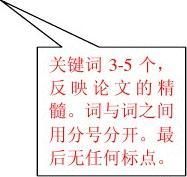

的重点研究课题。国内贾德江、刘宓庆,西方的R. Kaplan等学者对此课题进行
了深入的研究,并取得了令人瞩目的成果。中英思维方式的差异可以从很多方面
进行分类。中国人的思维总的来说是如重意象的直观性,对事物规律的归纳总结
和重视主体的感受和内在逻辑性联系的意合,体现为主螺旋型上升趋势,具有明
显的模糊性。而英国人的思维方式则重理性与分析性,注重对客体的临摹与再现,
所以其思维呈直线状态,具有精确性的特点,强调严谨的外在形式的融合等。当
然不同的学者也从其他方面进行了分类。这些思维方式在两个民族的语言上也有
充分的体现,从词汇、句法、语义、语法和文体上分别呈现了明显的差异。对这
些差异的忽视往往导致中英翻译中出现各种错误,如过于拘泥于原文的字面,忽
略两种语言的句法特征,忽略不同的视角和文体特色,或者由于句法差异而导致
在目的语的累赘表述等。
为了避免上述问题,通常要有充分的文化背景知识,然后采取转换翻译策略,
包括词类,词义,句法结构等的转换,同时也可以采取临摹翻译法和反向翻译法
等策略。由此可见,思维方式的差异对翻译质量的影响不容忽视,必须采取相应
的策略,以提高翻译质量。(400-450字)
[关键词]
X
Abstract
Thought, language and culture are closely interrelated. Language embodies thoughts and thoughts dominate language, but both under the general framework of culture. Different thinking modes of the Chinese and the Westerners have always been a top academic issues. Such academic celebrity as Jia Dejiang, Liu Miqing, R. Scholar and Kaplan have conducted systematic studies on it and have yielded amazing results. Differences in Chinese and English thinking modes can be classified in various aspects. Chinese thinking modes tend to focus on visual effects, to generalize, be subject-oriented, tortuous and fuzzy, and above all be paratactic. The English thinking modes on the other hand are generally rational, analytical, object-targeted and straight forward and tend to by accurate and above all focus on hypotaxis. Of course other scholars may classify them from some other aspects. These special features in thinking modes are fully manifested in the two languages, lexically, syntactically, semantically, grammatically and contextually. Ignorance of these features may cause negative effects on translation such as stubborn rendering resulting from ignorance of different syntactic preferences, misleading rendering due to differences in viewpoints, awkward transferring for ignorance of rhetoric preference, inaccurate translation caused by improper diction or wordy diction regardless of the syntactic structural differences.
In order to avoid the above problems, sufficient cultural background information will be helpful and strategies such as shifting translation, graphic translation, backward translation shall be adopted. It can be thus concluded that translation cannot afford to neglect differences in thinking modes and that the corresponding strategy may greatly help improve the translation quality. (中文摘要的对应译文)
[Keywords] Chinese and English
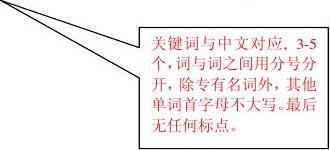
embodiment; translation strategies
XI
Contents
1 Introduction……………………………………………………………...………..1
2 Literature Review……………………………………………………...………...2
2.1 Aristotelian school: metaphor—a device of rhetoric……………..……….2
2.2 The platonic school—language is metaphorical……………….……………. 5
2.3 The study of metaphor from the 20th century to the present………………...…..6 3 On Similarity……………………………………………………………………7
3.1 Similarity: a fundamental criterion for the classification of metaphor…...……..7
3.2 Similarity and culture………………………………………………………….9
3.3 Similarity and category………………………….……………………………10
3.4 The relationship between similarity and knowledge……………………….13
4 On the Mechanism of Metaphor…………………………….………………...15
4.1 Black’s interaction theory………………………………………....................15
4.1.1 Introduction to the interaction theory…………………………………...15
4.1.2 Some defects of the interaction theory…………………………………16
4.2 Lakoffian conceptual metaphor theory……………………………………...19
4.2.1 The philosophical basis of lakoffian theory…………………………...19
4.2.2 Lakoffian theory on the mechanism of metaphor………………………21
4.2.3 The deficiencies of Lakoffian theory in expounding the creation of
similarity…………………. ……………………………………………...26
4.3 Conceptual integration theory……………………………………………….29
4.3.1 An introduction to the conceptual integration theory……………......…....29
4.3.1.1 Four mental spaces……………….………………...……………..29
4.3.1.2 Three processes of BT………………..……………..……………..33
4.3.1.3 Optimality principles of BT………….…………………...……….34
4.3.2 The advantages of BT in solving the paradox of the to former
theories…………………………………………………………….……...34
4.3.2.1 The generic mental space…………………………….…...……...34
4.3.2.2 The blending space and emergent structure……..…………..…...35
4.3.2.3 The other advantages of BT………………..…………..…………40 5 Conclusion………………………………………………….……………………42 Works Cited………………………………………………..………………………45 Acknowledgements……………………………………………….………………………46 XII
1 Introduction
Language by nature is the embodiment of human thoughts and thoughts in turn is the mental reflection of the world around us on basis of some analysis, generalization, judgment and reasoning. Animals have thoughts as well, but their awkward sounds for communication are far from being language. Language is therefore closely related to and supported by human thoughts. That is to say, language has no basis for its existence if there is no thought. But thoughts, though accessible by various means, are best represented in language and can thus best fulfill its obligations to the speakers by such means. Language as an arbitrary, phonetic and morphologic semiotic and audio system of communication, has long defined as human and is thus the most convincing distinctive features of human beings from animals.
The thinking patterns are one of the most important cues in culture. It is closely related to cultures and embodies the characteristics of cultural psychology. Besides, the modes of thinking also are closely related to language. Different modes of thinking are embodied in language.
(i) The relationship among language, culture and thought
Language is part of culture. Such as Chinese language is part of Chinese culture. Each country has its own language in a specific culture. However, their relationship is not just between part and whole. Language is the carrier and contained of culture, as many aspects of culture can be expressed in language. As a mirror of culture, language is strongly influenced and shaped by culture. In all, language and culture are closely related; each influences and shapes the other.
Language is an instrument used in the communication of thought. It is closely related to thought, too. It represents thought and is influenced by thought. In turn, thought is influenced by language. In addition, thought is determined by cultural value. Their relationships with each other seem more complex. In a word, each of them influences and shapes others. They are seen as three parts of a whole.
(ii) Different ways of thinking between Chinese and Western
“The ways of thinking is quite different, actually, people live in certain area have their own way of thinking. It connects to various kinds of factors, such as geography, history, nation and so on. The ways of thinking are the important reason of cultural difference. It includes knowledge, concepts, methods, language and custom and so 1

different ways of thinking. Therefore, the ways of thinking have their own characteristics, like geography characteristics, social characteristics and national characteristics, etc. According to geography characteristics, it can be divided into Han nation, English and American nation, etc. Here we will make a comparison on Chinese and Western ways of thinking.
三行(含)以上
的引文:前缩进
10个字符、后不
缩进,上下各空
1行。 “The different ways of thinking in fact are the reflection of cultural difference. People who live in different areas for a long time have different cultural characteristics; therefore, their ways of thinking are different.”
(ibid. 484)
Under the influence of different geography environments, life styles, customs ibid, 表示此处所引文字与上一处所引出处相
同,页码
另行标
注。 and different cultural values; the East and West are different from ways of thinking. Let us examine some phenomena:
In the college, a foreign teacher is teaching in a class, he is talkative and expressive. Everyone listens to him interestingly. Suddenly, he stops and asks them a question. However, the students don’t know how to answer, they don’t tell the answers. The teacher got a little angry but he had no idea on their behavior. This scene often happens in Chinese classroom. In the foreigners’ eyes, they consider that keeping silent is not a good way when we contact with others. Even you don’t understand, you should say something instead of keeping silent, as it often is regarded as rude and impolite.
The reason lies in that the East and the West have a different way of thinking. The Eastern people are conservative, introvert and inactive, they put more emphasis on harmony, and they like common and stable life; while the Western people are more open-minded, extrovert and active, they like changeable life and thus they emphasize on competition. In this way, their different ways of thinking lead to their different understanding on each other’s behavior. If Chinese see somebody is talkative, they could think he or she wants to extent himself or herself to be the focus of everyone.
In China, we seldom see a couple making close contact in public. They are always walking side by side in a certain distance. While in the West, the couple will open to the public; they are free to show that they are a couple. Even they meet the 2
acquaintances; they always give them a hug or kiss as greeting. Controversially, Chinese will shake hands with their friends but seldom hug them. They don’t kiss them as they regard it as an intimate action between husband and wife.
The reason why the east and the west people behave so differently is that people live in the East emphasize on ethic principal, morality, they focus on direct feeling and image. The westerners focus on freedom, democracy and emphasize on individual.
In all, Chinese traditional way of thinking has its own characteristics. It emphasizes the morality, harmony of the society; it promotes the collectivism, responsibility and devotion and so on. The western way of thinking also has its own characteristics. It emphasizes on logic and science, individual achievement, it promotes human right, equality and so on.
The great geographic distance between the British and the Chinese peoples, together with the accompanying different living conditions and cultural environments, has much accounted for the diverse conceptual patterns of the two nations. Such conceptual differences have been duly reflected in and shed great influence on the two languages. Translation between the two languages is consequently far beyond linguistic rendering, but more of cultural transferring and exchange of conceptual patterns.
3
Undergraduate Thesis of School of Foreign Studies of Yangtze University
2 Literature Review
According to Jia Dejiang, “thinking patterns, thought characteristics and thinking styles are the philosophical mechanism of language production. Language actually attaches closely to the thought that is the profound mechanism.”(Jia Dejiang, 2002: 166)
……
All metaphors, Aristotle believes, fall into at least one of these four categories, although analogy metaphors are the most pleasing. Aristotle also holds that metaphor can make the prosaic style charming, and stresses that it can only be confined to poetry (ibid. 72). This perspective leads to the later theorists making distinction between poetic language and everyday language. Especially in Chapter 21 and 22 of Poetics, Aristotle states that every word “is either current, or strange, or metaphor, or ornamental, or newly coined, or lengthened, or contracted, or altered”(ibid. 70). - 4 -
Undergraduate Thesis of School of Foreign Studies of Yangtze University
3 Differences Between Chinese and English Thinking Modes
As discussed above, differences between the Chinese and the English in their thinking patterns are obvious among scholar. The differences among scholars’ attitudes or classification of the thinking patterns between the two nations are not essentially diversified but rather lie in the degree of detailed typology. Actually, the issue can be approached and considered from various viewpoints. Here are but a few instances for illustration.
3.1 Differences between Chinese and English thinking patterns
3.1.1. Visual thinking vs. rational thinking
The visualized thinking mode, or empirical synthesizes thinking pattern as Zheng Yanhong (Zheng Yanhong, 2003: 51) puts it, ……
The Chinese, on the other hand, seem more favorite of concrete images and tend to reflect on the world from the view point of specific objects. They would rather describe the objects to generalized principles and inspirations. That to great extent accounts for the image thinking modes of the Chinese. E.g.
1a. But this very formulation is indicative of the understanding attitude. 1b. 但这一说法本身就清楚地表明了其基本态度。
2a. His weariness and increasing heat determined him to sit down in the first
convenient shade.
2b. 他疲惫不堪,天气也越来越炎热,于是他下定决心一碰到舒适的阴凉处就
坐下休息。
3a. Shortness of time has required the omission of some countries.
3b. 由于时间不够,他取消了对某些国家的访问。
In the above specimen of 1a, 2a and 3a, the subjects are not any person or object but rather some state or concepts although the sentences are more person-oriented. Yet in the Chinese version, the persons concerned are used as the subjects to directly reveal the speaker’s concern.
Even when the Chinese means to express some attitude or impression, they may not state it directly but rather use metaphor or indications by means of some specific - 5 -
Undergraduate Thesis of School of Foreign Studies of Yangtze University
images. e.g.
4a.He had sacrificed with less visibility in the policy decision.
4b.在决策过程中,他已经不那么抛头露面了。
5a.我的心里七上八下的。
*5b.There are seven ups and eight downs in my heart?
5c.My mind is greatly upset.
The concept of “visibility” in 4a is replaced by the image expression of “抛头露面” in 4b in which “头”(head) and “面”(face) are used to show his presence or visibility in the occasions. In 5a and 5b, the specific numbers of “七”(seven) and “八”(eight) in the Chinese are replace by “upset” in English because the Chinese phrase “七上八下” just use the two numbers to vividly describe the get chaos in the speaker’s mind. Yet 5b, the direct rendering sound rather confusing to English readers as few of them can understand why there are such things as “seven ups and eight downs” in a person’s mind.
Such instances are just abundant in our daily speech, not to mention the numerous classic essays and literary masterpieces and EST papers.
3.1.2 Generalizing thinking vs. analytical thinking
The differences of philosophy and cultural background between English and Chinese have resulted in the rethinking of the Han nationality as an entirety thinking country and the English people individual characteristics of thinking.
…
3.2 Linguistic features resulting from differences of thinking patterns
The effect of different thinking modes on linguistic construction is also apparent in the lexical, syntactic, contextual and grammatical features of the two languages.
3.2.1 Lexical Features
In some other grammatical aspects, Chinese has no grammatical changes in the morphemes while it is just too common in English to change the forms of words for different grammatical functions.
- 6 -
Undergraduate Thesis of School of Foreign Studies of Yangtze University
4 The Impact of Thinking Patterns on Translation
In practical translation, green hands have never shown enough errors resulting from insufficient consideration of the different thinking modes between the English and the Chinese. Such translations are usually literally and grammatically flawless, and sometimes read native, yet genuine native speakers of English will feel awkward in reading such translation and yet stay at loss where the problem lies. Such problems can be categorized into five: stubborn rendering, misleading rendering, awkward transferring, wordy diction and inaccurate translation in sequential ranks in light of degree of inaccuracy.
4.1 Stubborn rendering resulting from ignorance of different syntactic preferences
……
It’s not difficult to find that the above translations are all acceptable to the TL readers but those with “*” are much inferior in diction and do not offer native English narrations. Such requirement is somewhat beyond the translation strategies but is also quite helpful to improving the quality of our translation. Translators may achieve this goal by improving their own writing skills.
- 7 -
Undergraduate Thesis of School of Foreign Studies of Yangtze University
5 Some Practical Approaches in Translation Between the Two Languages
5.1 Sufficient cultural background information
Sufficient cultural background information is not only helpful but also necessary in successful translation between two languages as distant from each other as Chinese and English. But it’s easier said than done, as culture is such an all-round concept and concerns so may aspects of our lives and languages. No one can be fully informed in this aspect, and what we can do is try to learn more about it and put it into our translation.
……
60c:在这种情况下, 你可要明白, 虽然你还可以在物质方面给他们以帮助, 比如给他们零用钱, 或者为他们织毛衣, 但你绝不要指望他们会喜欢跟你做伴。 It’s not difficult to find that backward translation has made 60c a much better translation of 60a. Actually in longer contexts, backward translation is even more important and beneficial.
- 8 -
Undergraduate Thesis of School of Foreign Studies of Yangtze University
6. Conclusion
From the comparison of the English-Chinese languages and their modes of thought, we may see that they are of one thing but two aspects. Resulted from different cultural background, the differences of their modes of thought have greatly determined their own languages. On the other hand, the languages also reflect and influenced their thinking patterns. So in order to learn English well and better master the two languages the thinking patterns should be studied deeply. In my own opinion, the study of languages from the degree of thinking pattern will greatly benefit the learners. For example, it will give the guide to the teaching of second language and the writing of composition. Of course mode of thought belongs to philosophy. So it is a very complicated concept, and to go deep into it will need a very long time and also requires many efforts.
- 9 -
Undergraduate Thesis of School of Foreign Studies of Yangtze University
Works Cited
[1] Alderson, J. Charles, Caroline Clapham and Dianne Wall. Language Test
Construction and Evaluation[M]. Cambridge University Press, 1995: 171-177.
[2] Bly, Robert. The Eight Stages of Translation[A]. William Frawley. ed. Translation:
Literary, Linguistics, and Philosophical Perspectives[C]. University of Delaware Press, 1984: 67-89.
[3] Gavison, Ruth. Legal Protection of Privacy[D]. An Oxford University Dissertation,
1975.
[4] Hale, Gordon A. and Rosalea Courtney. The Effects of Note-Taking on Listening
Comprehension in the Test of English as a Foreign Language[J]. Language Testing, 1994(1): 29-48.
[5] Online Computer Library Center, Inc. History of OCLC[EB/OL]. [2000-01-08].
/about.en.html.
[6] Richards, Jack C. Listening Comprehension: Approach, Design, Procedure.
TESOL Quarterly[J], 1983(17): 219-240.
[7] Wang, Ning. Globalization and Cultural Translation[M].Cavendish Square
Publishing, 2005.
[8] [德]海德格尔.存在与时间[M].陈嘉映,王庆节译.生活?读书?新知三联书
店,1999:2-3.
[9] [美]杰夫?特威切尔.庞德的《华夏集》和意象派诗[J].张子清译.外国文学
评论,1992(1):86-91.
[10] 曹明伦.“我是否可以把你比喻成夏天?”——兼与沈弘先生商榷[J].外国
文学评论,2008(3):35-40.
[11] 丁文祥. 数字革命与竞争国际化[N].中国青年报,2000-11-20(15).
[12] 国家标准局信息分类编码研究所.GB/T 2659-1986 世界各国和地区名称代
码[S]//全国文献工作标准化技术委员会.文献工作国家标准汇编:3.中国标准出版社,1988:59-92.
[13] 蒋显菊.国内英语测试研究:十年回顾与展望[J].外语界,2007(2):89-96.
[14] 萧钰. 出版业信息化迈入快车道[EB/OL]. (2001-12-19) [2002-04-15].
/01ds/2001-12/19/07-1C6612DEBB971BF148256B2700043372.htm.
[15] 张俊杰.试论中庸诗歌翻译观的构建[D].河南大学博士论文,2010.
[16] 钟玲.王红公英诗里的中国风味[A].郑树森,周英雄和袁鹤翔合编.中西比
较文学论集[C].时报文化出版事业有限公司,1980:103-134.
[17] 邹申.语言测试[M].上海外语教育出版社,2005:25.
以上仅为示例。所列文献与正文中的文献引用必须一致。
- 10 -
Undergraduate Thesis of School of Foreign Studies of Yangtze University
Acknowledgements
I have eternal gratitude to…, my thesis supervisor, for his inestimable help and valuable instruction, and to Professor …, for his insightful lectures, which inspire me to compose this thesis.
I am greatly indebted to Professor … for his allowing me to have access to his books pertinent to this thesis.
I also thank those who help me in course of the writing and whose names I can’t list here one by one.
(“论文导师”,统一称 “thesis supervisor” 。致谢需改写。)
- 11 -
长江大学毕业论文(设计)课题申报、审核表
(2014—2015学年)
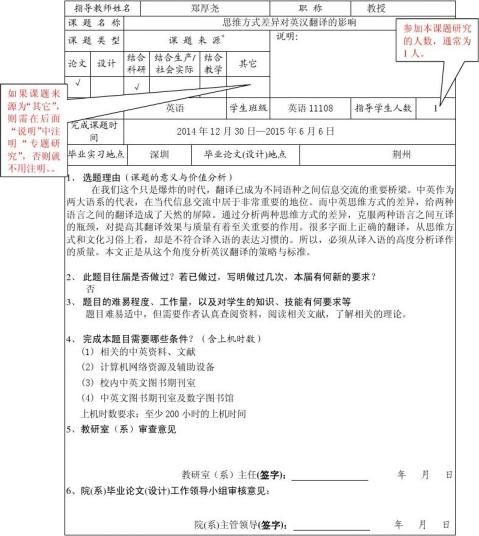
请写明题目来源单位;若结合教学,请写明与教学相关的内容,如为实验室建设,写明为哪个实验室,哪项技术改造或实验项目开发。
I
以下资料是为大家写作之需而提供,非本格式要求内容。
英语专业毕业论文写作资料查询网址
1. 中国国家图书馆:http://www.lib.
2. 清华大学图书馆:http://www.lib./
3. 北京大学图书馆:http://www.lib./
4. 北京师范大学图书馆:http://www.lib./
5. 南京大学图书馆:http://202.119.47.3/
6. 复旦大学图书馆:http://www.library.
7. 北京外国语大学图书馆:http://www./enet/lib/tsg.htm
8. 厦门大学图书馆:http://210.34.4.20/
9. 广东外语外贸大学图书馆:http://202.116.197.6/gplib.htm
10. 美国国会图书馆:http://leweb.loc.gov
11. 英国外语辅助教学图书馆:http://www.sussex.ac.uk/langc/call.html 12. 美国世界图书馆网络中心:http://library.usask.ca/ejournals
13. 人文科学在线杂志图书馆:http://166.111.88.20/index.htm
14. 中国在线图书馆:http://netsupport./navigation/navindex.htm 15. OCLC联机计算机图书馆中心:/
16. 语言文学在线资源库(Online MLA International Bibliography):/catalog/mlab.htm
17. 英语和外语教学在线杂志:/eflweb/home.htm 18. “美国研究”网页:http://www.georgetown.edu/crossroads/asw
19. ERIC英语教学文摘档案库:http://eric-web/tc.columbia.edu/abstracts 20. 中国期刊网:http://166.111.88.20/index.htm/
21. 美国ISI公司Arts and Humanities Citation Index (A & HCI)-1975-present:/help/helptoc.html#abhci
22. 美国ISI公司Social Science Citation Index (SSCI)-1975-present:/help/helptoc.htmo#ssci
23. Uncover期刊论文原文传递服务系统:/reveal/ 24. 美国Brown大学语言学虚拟图书馆:http://www.cog.brpwn.edu/pointers/liguistics.html 25. 英国London大学Berkbeck学院应用语言学图书馆:http://alt.venus.co.uk/VL/AppLingBBK
26. 美国ERIC(教育資源信息中心)语言与语言学资料交换中心:opher://ericir.syr.edu:70/11/clearinghouse/16houses/CLL/ERIC-LL
国内外外语与外语教学类网址
1. Applied linguistics virtual library: http://alt.venus.co.uk/AppLingBBK/welcome.Html 2. Human language page: http://www.June29.com/HLP
3. Linguistic resources on the Internet: /linguidtics
4. Universal survey of language: /~napoleon
5. 中国基础教育网:.cn
6. 中国英语教师网:.cn
7. 美国全球英语学习网:
外国语学院英语系、商务英语系
20xx年12月
II
